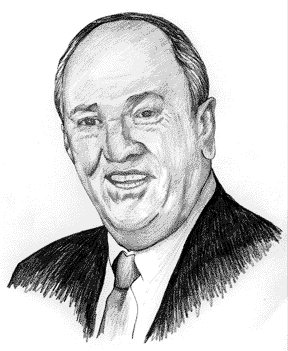INTERVIEW
A Guide To Conquering The Trading Markets
Kevin Haggerty
by Thom Hartle
Kevin Haggerty's career on Wall Street covers nearly 25 years and numerous responsibilities ranging from senior vice president and manager of equity trading at Fidelity Capital Markets to serving as a managing director of the Chicago Board Options Exchange. Now he's teamed up with Mark Boucher and Larry Connors, some other noted names in the business that STOCKS & COMMODITIES readers may recognize, to cofound a Website for traders called TradeHard.com. S&C Editor Thom Hartle spoke to Haggerty on May 18, 1999, about topics ranging from stockpicking, the opportunities available due to the way major players move in the markets, and his upcoming book, as well as his contribution to The TRADEHARD.com's Guide To Conquering The Trading Markets.

ILLUSTRATION BY CARL GREEN
Let's start with a little history.
Before entering the trading industry, I received my bachelor's degree from Manhattan College, and served in the US Marine Corps from 1965 to 1969. From 1976 to 1981, I was a vice president at Dean Witter Reynolds and manager of the equity and convertible trading desk. I became a general partner in charge of equity and convertible trading at Walsh Greenwood, where I was from 1981 to 1990. While there, I also directed the sales and marketing of the SHARK system, the first personal computer–based equity and option trading quotation system. From 1990 to 1997, I served as senior vice president and manager of equity trading at Fidelity Capital Markets, a division of Fidelity Investments, where I was in charge of US institutional equity trading and exchange floor operations.
You've also sat on various exchange-related committees?
I was a managing director of the Chicago Board Options Exchange; member of the New York Stock Exchange (NYSE) Stock Allocation Committee; member of the Chicago Stock Exchange board of governors; member of the NYSE upstairs trading advisory committee (UTAC); a member of the SIA Committee to advise the Securities and Exchange Commission on various aspects of the securities industry; and a member of the National Organization of Investment Professionals (NOIP).
Often, people start out looking at fundamental analysis and then switching to technical trading strategies. Did you go through that process?
Well, I have looked at and done just about everything by now. The approach I take is different from that of most other traders, due to my background. With my experience, I've seen many different institutions and how they traded. For example, traders look at classical chart patterns -- say, symmetrical triangles -- and in the commodities markets, it's classic demand and supply. But in our market, there is a tremendous amount of interplay that occurs between the major mutual funds, money managers, the hedge funds, upstairs traders, marketmakers, and the specialists on the New York Stock Exchange. Understanding how that cycle works and relating that cycle to the markets will help you find high-probability situations. That includes technical analysis. That's what I do.
How did your approach evolve?
Over the years, I've saved patterns from almost all the trades I've done and seen executed, so I've collected a wealth of information. I have a good feel for how institutions react in different situations. Their reactions result in consistently reappearing patterns in the market. In fact, the trends and the patterns that reappear, and how to identify them in the marketplace, are the basis for a book that I am currently writing. It should be out next year.
Everyone's writing a book. What's different about yours?
I want to bridge the gap that exists between how most new investors and traders view the workings of the equity markets and how those markets really work.
How are you going to do that?
By showing the value of combining the understanding of market dynamics with some technical patterns, some classical patterns, and some others. For example, some patterns are dictated by what specialists might do on openings. One I describe in our current book is referred to as the trap door. Understanding the mentality of the specialist enables you to feel comfortable going in and placing a trade based on this pattern. But you can't see the opportunity unless you understand how specialists work and how they handle openings, and how the institutions or different market participants react on openings.
So what is the trap door?
It's a daytrading strategy for long-side price momentum trades that takes advantage of emotional down openings that snap back. In today's markets, the tail is wagging the dog. The NYSE, especially at the opening, is affected by the futures markets. But if you understand the specialists and how the institutions or different people react to down openings, you can take advantage of these situations.
In our market, there is a tremendous amount of interplay between the major mutual funds, money managers, the hedge funds, upstairs traders, marketmakers, and the specialists on the NYSE. Understanding how that cycle works and relating that cycle to the markets will help you find high-probability situations. That includes technical analysis. That's what I do. -- Kevin Haggerty
Excerpted from an article originally published in the August 1999 issue of Technical Analysis of STOCKS & COMMODITIES magazine. All rights reserved. © Copyright 1999, Technical Analysis, Inc.
Return to August 1999 Contents